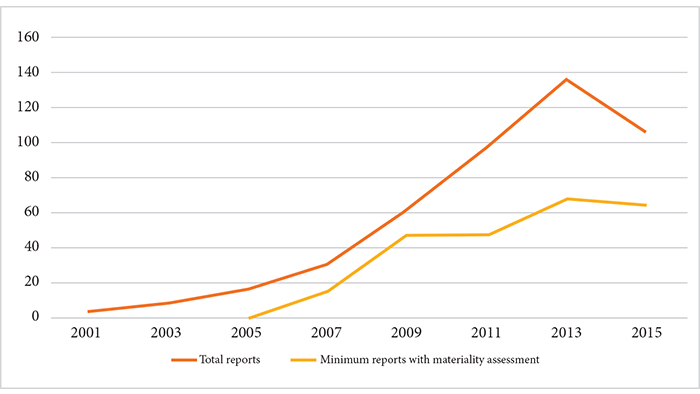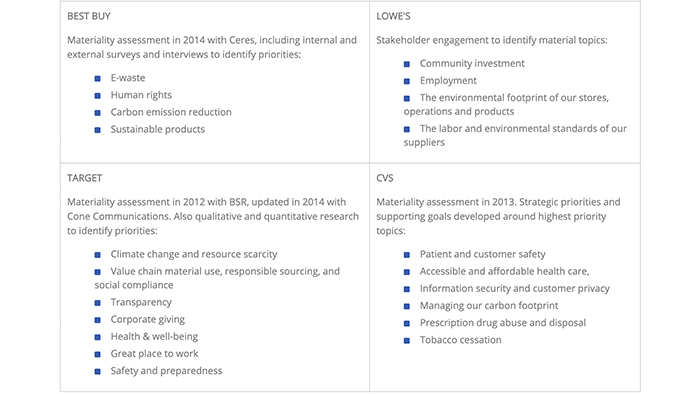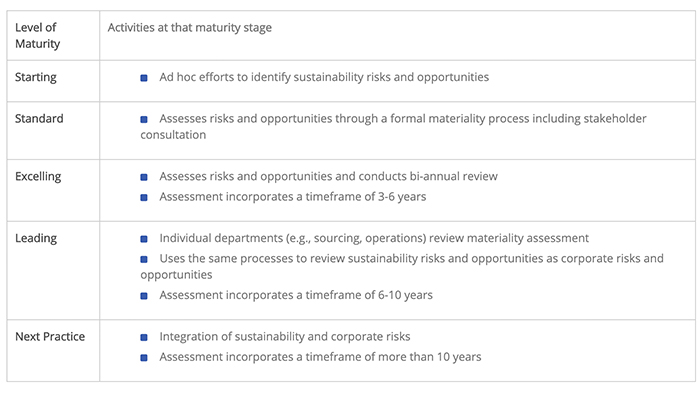What Materiality and Risk Identification Offer for Retail
Materiality in a sustainability context refers to social and environmental factors that matter to the business and their stakeholders. Materiality is often viewed from a financial perspective as the factors that will impact, positively or negatively, a firm’s financial performance. Gap Inc. defines materiality as “prioritizing what matters most.” CVS Health conducts a materiality assessment to “ensure we are addressing and reporting on topics that reflect our significant economic, environmental and social impacts, or that substantively influence the assessments and decisions of our stakeholders.”
Assessing Materiality
Many retailers, as well as multinational corporations across other sectors, conduct materiality assessments to identify the specific sustainability topics that are most important to their business and their stakeholders. Companies use this information to inform business decisions and to focus their external reporting.
Considering Retailers
Inform business decisions. Assessing the materiality of each sustainability topic uncovers the opportunities and risks that arise from the many ways that retailers interact with society and the environment. Companies use this information to inform business decisions and direct resources to what matters. As an example, Gap Inc. keeps executives and board members updated on the topics most material to its business, which "informs business strategy and enhances its implementation." As a second example, Best Buy adjusted its business offerings, based in part on its 2014 materiality assessment. While the assessment reinforced Best Buy's existing activities, it identified "helping customers choose more sustainable products" as a topic the company should put more focus on.
SUSTAINABILITY TOPICS MOST MATERIAL TO RETAIL*
- Environmental impacts of transporting employees as well as products, other goods and materials
- Percent of suppliers, contractors and other business partners screened for human rights practices, and actions taken
- Percent of products, and life cycle stages, assessed for health and safety impacts
- Indirect energy consumption reductions achieved
- Products and packaging percent reclaimed by product category
- Energy conservation and efficiency savings achieved
- Full-time employee benefits not provided to temporary or part-time employees, by major operations
- Indirect GHG emissions by weight
- Number of incidents of product health and safety non-compliance with regulations or voluntary codes, by type of outcome
- Greenhouse gas emission reductions
* A 2018 study of sustainability reports ranked the materiality of 91 topics, according to how fully the topic was covered in external reports from retailers that include Ahold, Best Buy, Delhaize Group, Marks & Spencer, Metro, Migros, Staples, Target, The Kroger Company, Wal-Mart, and Woolworths Limited. In addition to the ten topics listed above, child labor, prevention of forced labor, freedom of association and collective bargaining were also among the top topics for the retail sector. A separate survey conducted in 2012 (p. 65) also offers guidance for retailers, presenting the 33 topics that financial markets and civil society deemed most material within the retail sector.
Inform reporting. Many retailers use the results of materiality assessments to focus their sustainability reporting. Investors analyze company reports on sustainability risks and opportunities in their investment decisions. In 2014, nine U.S. retailers and over 75 retailers worldwide conducted materiality assessments that informed their public sustainability reports. In the same year 14 U.S. retailers included non-financial information on material sustainability topics in their financial filings, as well as details on how each topic "impacted the company's… business risks and opportunities." These retailers include Costco, Lowe's Companies and Whole Foods Market. The risks related to management of the workforce, customer privacy, supply chain risks, and climate change were among the topics included in 10-K filings of Best Buy, Walmart and others.

Figure 1. Materiality assessment in retail, by the number of external sustainability reports which include a materiality assessment
Source of data: database.globalreporting.org
HOW DOES RETAIL ASSESS MATERIALITY?
To prioritize topics, companies weigh the strategic importance to the business, importance to stakeholders and the scale or nature of impacts on the environment or society. Most companies also assess how a topic will impact business operations or reputation, which is important to public facing retail. The GRI 101 Foundation guidance has information on the importance of materiality and reporting.
The GRI standards also provide guidance on criteria for testing whether a topic is material. "In defining material [topics] the organization takes into account the following factors":
- Sustainability-specific impacts, risks or opportunities
- Interests of direct stakeholders (employees, shareholders, suppliers) and indirect stakeholders (local communites, civil society)
- Values of the organization
- Insights and knowledge within the sector
- Compliance with regulations and voluntary agreements
- Risks to the organization
- Ability of the organization to act, influence or contribute.
Materiality Assessments at Four Retailers

Maturity Steps for Materiality & Risk Identification
To enable retailers to benchmark their activities, RILA provides the RILA Retail Sustainability Management Maturity Model. The model includes a specific dimension on materiality as well as resources:
Tags
-
Retail Sustainability
-
Sustainability & Environment



